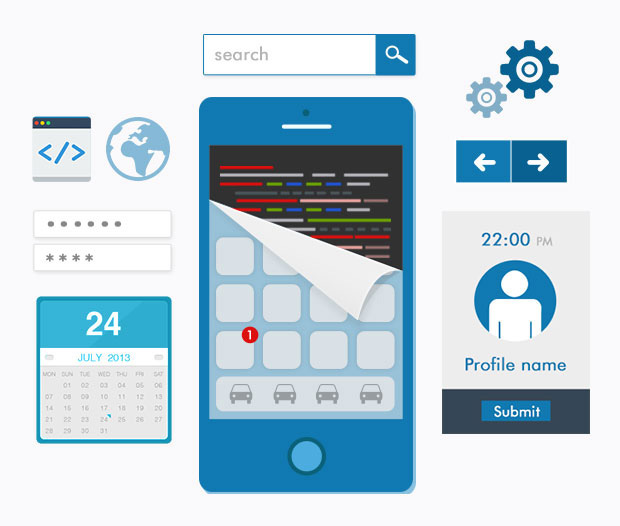
Mobile App Design
Since past few years, we have seen an exponential growth in the usage of mobile apps which makes it of paramount importance for every business to own an app. It not only helps the businesses to stay in touch with their customers & receive feedback but also to continue the process of consumer engagement to retain them. Creating a mobile presence for your business is no longer a luxury, but a necessity. Mobility has changed business forever. The first step in mobility is to own an app to drive engagement with your consumers. This is where the concept of visual design (how it looks), an intuitive UI (how it works), and an engaging UX (how it feels to the user) comes into picture.
This is What We Help You with:
- Create an appealing visual design, an intuitibe UI and an engaging UX thus helping you to convert more prospects to clients.
- Create a cohesive plan for your app's software architecture before starting with development, thus making the app scalable for future additions/changes.
- Create clear call-to-actions persuading users to take an action as per your requirement.
- Help reduce the 'cost of ownership' by making an intuitive design.
Our Process for Mobile Application Design
Introduction and Analysis
We talk with you to gauge understanding about your vision, purpose and direction. This is important to get a clear idea of what problems you’re trying to solve with the app before starting to really firm up the concept. After nailing down the objectives, we identify your audience and perform other market research pertinent to the project.
Creation of Technical Specification Document Based on SRS
After we are done with our initial research and have our objectives and value propositions laid out, we get the software requirements specification (SRS) document from you which lays out the business logic of your app (We can help you create the specification document in case you do not have the resources for the same). Based on the specifications, we create and share with you a 'technical specification document' which scopes out the features and functionality of the app.
Creation of Flowmap
The technical specification document is shared with our web team to create a flowmap to ensure a logical and correct navigational structure before the creation of wireframes. This is imperative as skipping the flowmap and simply designing or wiring screens without a plan can lead to a convoluted flow that can leave the users confused.
Wireframe Design
The technical specification document along with the flowmap is shared with our web team and we initiate the process to create wireframes as per the specifications laid out. These wireframes act as a 'user experience (UX)' roadmap - demonstrating what a user’s options will be - and an 'information architecture' blueprint, laying out which parts of the site will have what content. This is important to decide the flow of the app.
Designing Mockups
After the wireframes are approved by you, our designers start designing the mockups based on the wireframes. We make sure that we create an appealing visual design (how it looks), an intuitive UI (how it works), and an engaging UX (how it feels to the user). This whole process consists of creating the look and feel of each screen for the app complete with all the graphics, icons, animations and other elements needed as per requirement. We share the round 1 mockups with you for your approval. In case of any changes suggested by you, we create a 2nd round of mockups including the changes and share the same with you again.
Prototyping
After the mockups are approved by you, we create the prototypes for our developers. Our designers remain engaged throughout the development phase to address any issues or ideas the developers may have about the project.
Software Architecture Planning
This includes creation of a cohesive plan for the software architecture of the app - both the front-end and the back-end architecture. We need to make sure that the app is scalable/extensible i.e. In case you need to include new features to it down the line, it should support the same with ease and should not lead to recode everything to extend it. “Architecting” phase happens parallel to design so that we’re ready to kick off the development phase next.
Development
Once we have the design and architecture planning in place, we start with front-end and back-end coding. This is a co-ordinated effort in which which both our designer and development team collaborate to achieve the desired results. Writing unit tests and running integration testing are imperative steps in this phase.
Testing
After the app is fully developed, our developers go through the whole app screen-by-screen to test its functionailty and ensure that there are no bugs. Depending upon the kind of app (Hybrid or Native), we test the app across different devices as things like battery life, screen resolution, processors, and memory are different on each and affect how your app runs. We test the app for functionality (does it work well?), load time and handling (does it slow down when traffic increases?), and UX (how easy is it to learn or get used to?).
Submit the App for Review
Once the app is tested, it now needs to be submitted to the respective store - Apple store (For IOS apps) or Google play store (For android) apps. The submission process for Apple store might take a while as it might involve a few fixes and resubmissions. The steps include configuring the code, creating a profile, creating a listing, then submitting it through Xcode for certification. The process for submitting an app in Google play store is much easier.

